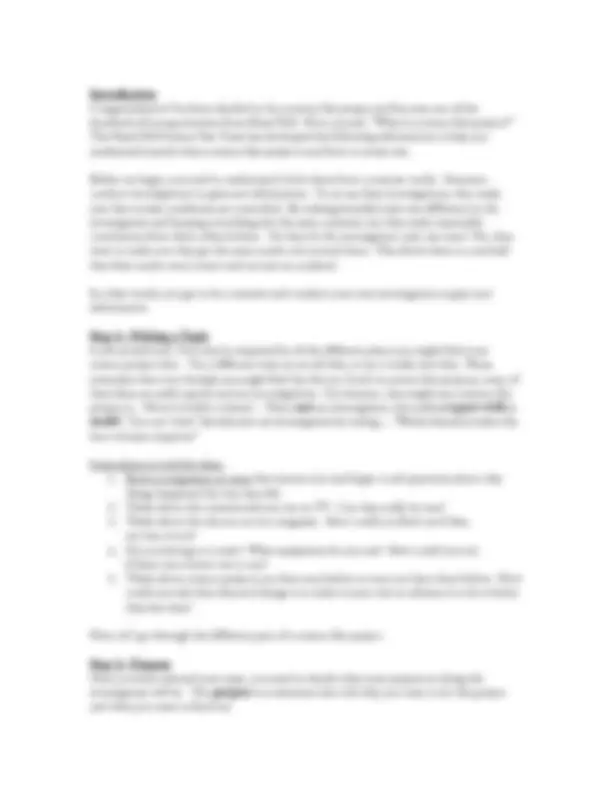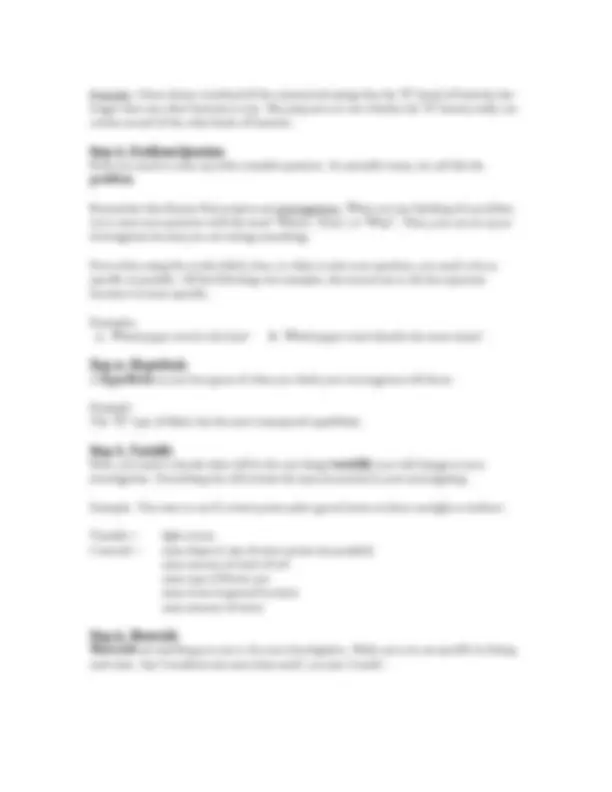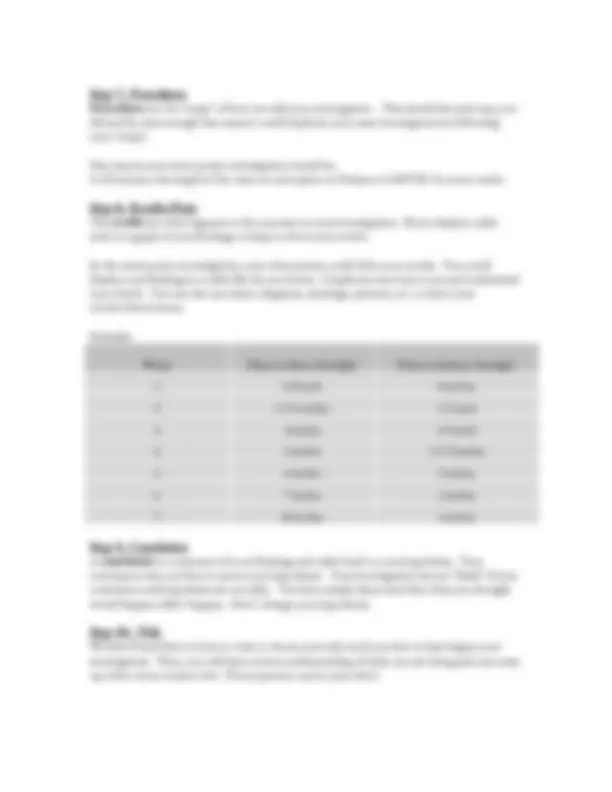






Study with the several resources on Docsity

Earn points by helping other students or get them with a premium plan


Prepare for your exams
Study with the several resources on Docsity

Earn points to download
Earn points by helping other students or get them with a premium plan
Community
Ask the community for help and clear up your study doubts
Discover the best universities in your country according to Docsity users
Free resources
Download our free guides on studying techniques, anxiety management strategies, and thesis advice from Docsity tutors
Information for students participating in the Hazel Dell Elementary Science Fair, including project setup times, judging and public viewing schedules, prohibited materials, and steps to create a science fair project. It also includes resources for finding science fair project ideas.
What you will learn
Typology: Exercises
1 / 8

This page cannot be seen from the preview
Don't miss anything!





A Science Fair for students in Kindergarten through 5th^ grade will be held Thursday, November 21, 2019, at Hazel Dell Elementary. Students participating in the Science Fair will be able to set up their projects at the school on Wednesday, November 19 between 2:30 – 3:30 p.m. or Thursday, November 21 from 7:00 – 7:45 a.m. Set up time will NOT be for public viewing. All Hazel Dell students will view projects on Thursday, November 21 in the afternoon. Judging of the projects will tentatively take place between 7:45 a.m. and 11:00 a.m. on Thursday, November 21. Public viewing of projects will tentatively be between 5:30 and 7: p.m. during the Hazel Dell Spectacular. After the Spaghetti Dinner, all students are welcome to take their projects home. The students going on to the Regional Science Fair should see a member of the Science Fair Team for further information. Regional qualifiers should note that Regionals will take place Saturday, March 14, 2020, from 8:00 a.m. - 3:30 p.m. this year. (PLEASE NOTE: Only students in grades 4 – 5 are eligible to go to the Regional Science Fair this year. This is a new stipulation for the last two years from CIRSEF. Students will be honored across all grades by our Science Fair Team.) …………………………………………………………………………………………………………………………………….……
Science Fair Guidelines:
Example: I have always wondered if the commercial saying that the ‘X’ brand of batteries last longer than any other batteries is true. My purpose is to test whether the ‘X’ battery really can outlast several of the other kinds of batteries. Step 3: Problem/Question Now you need to come up with a testable question. In scientific terms, we call this the problem. Remember that Science Fair projects are investigations. When you are thinking of a problem, try to start your question with the word ‘Which’, ‘Does’, or ‘What’. Then, you can set up an investigation because you are testing something. Even when using the words which, does, or what to start your question, you need to be as specific as possible. Of the following two examples, the second one is the best question because it is more specific. Examples: A. Which paper towel is the best? B. Which paper towel absorbs the most water? Step 4: Hypothesis A hypothesis is your best guess of what you think your investigation will show. Example: The “X” type of fabric has the most waterproof capabilities. Step 5: Variable Now, you need to decide what will be the one thing ( variable ) you will change in your investigation. Everything else will remain the same (controls) in your investigating. Example: You want to see if a sweet potato plant grows better in direct sunlight or indirect. Variable = light source Controls = same shape & size of sweet potato (as possible) same amount & kind of soil same type of flower pot same room & general location same amount of water Step 6: Materials Materials are anything you use to do your investigation. Make sure you are specific in listing each item. Say ‘6 medium size navy bean seeds’, not just ‘6 seeds’.
Step 7: Procedures Procedures are the ‘recipe’ of how you did your investigation. This should list each step you did and be clear enough that anyone could duplicate your same investigation by following your ‘recipe’. One step in your sweet potato investigation would be: I will measure the length of the vines on each plant on Fridays at 2:00 P.M. for seven weeks. Step 8: Results/Data The results are what happens or the outcome in your investigation. If you display a table and/or a graph of your findings, it helps to show your results. In the sweet potato investigation, your observations could drive your results. You could display your findings in a table like the one below. Graphs are easy ways to see and understand your results. You can also use charts, diagrams, drawings, pictures, etc. to show your results/observations. Example: Weeks Plant in Direct Sunlight Plant in Indirect Sunlight 1 1/8 inch 0 inches 2 1 1/4 inches 1/2 inch 3 3 inches 3/4 inch 4 5 inches 1 1/2 inches 5 6 inches 2 inches 6 7 inches 3 inches 7 10 inches 4 inches Step 9: Conclusion A conclusion is a statement of your findings and refers back to your hypothesis. Your conclusion does not have to prove your hypothesis. Your investigation has not ‘failed’ if your conclusion and hypothesis are not alike. You have simply discovered that what you thought would happen didn’t happen. Don’t change your hypothesis. Step 10: Title We have found that it is best to wait to choose your title until you have at least begun your investigation. Then, you will have a better understanding of what you are doing and can come up with a more creative title. (Your question can be your title!)
Journal : A journal is a day-to-day record of how and what you did for your project. Abstract: An abstract is a one-page summary of your project. Internet Resources There are lots of websites for science fair ideas. Remember that your project is an investigation, not a report (how does a volcano work or how to make rock crystals). There are some websites (and books) that give ideas for reports, but they will call them a project. If in doubt, remember to use the words ‘which’, ‘does’, or ‘what’ in your question. If you need help deciding if you have a true investigation, please contact a Science Fair Team member. http://www.sciencekids.co.nz/projects.html https://www.stevespanglerscience.com/science-fair-project-ideas/ http://www.all-science-fair-projects.com/category0.html http://www.101science.com/science_experiments.htm http://school.discoveryeducation.com/sciencefaircentral/ http://www.sciencebob.com/sciencefair/ideas.php http://www.sciencebuddies.org/ Video Resources Some videos on the scientific method and the science fair, which may prove helpful, are available at… https://www.youtube.com/playlist?list=PLtQSfI6Wfo1R5ohXSPSAg6huhJ1ocQa4q&spfrel oad= Final Words of Wisdom Please remember that Science Fair projects are investigations. They are not reports (i.e. How does a volcano work?). When you are thinking of a project, try to start your question with the words, ‘Which’, ‘Does’, or ‘What’. Project Ideas Does temperature change the rate of reaction? (1st^ grade) Which cleans a penny best? (1st^ grade) Which paper airplane flies the farthest? (2nd^ grade) Which playground surface is the safest in fall? (2nd^ grade) Does temperature affect how far a football can be kicked? (2nd^ grade) Does arm movement during exercise increase your heart rate? (3rd^ grade) Which type of Maple tree gives the most syrup? (3rd^ grade) H2O: What’s in your water? (4th^ grade) Which catapult angle will shoot the farthest? (4th^ grade) Which bathing suit drags the most? (4th^ grade) Which diaper holds the most liquid? (5th^ grade) Eggcellent Fall: Which falls faster, a raw or hard-boiled egg? (5th^ grade)
What kind of wood produces the most heat energy when burned? (5th^ grade) What type of fabric is more flame retardant? (5th^ grade) The school library and our local city library has many books on science project ideas. Often these books will list experiments (How does a volcano work?), please make sure the idea you select is really an investigation where you are trying to find out something and not merely a report. (TIP: If you could look it up in a science reference book and find the answer, it is a report, not an investigation.) If your child is one of the eligible winners, please see a member of the Science Fair Team for Regional information.